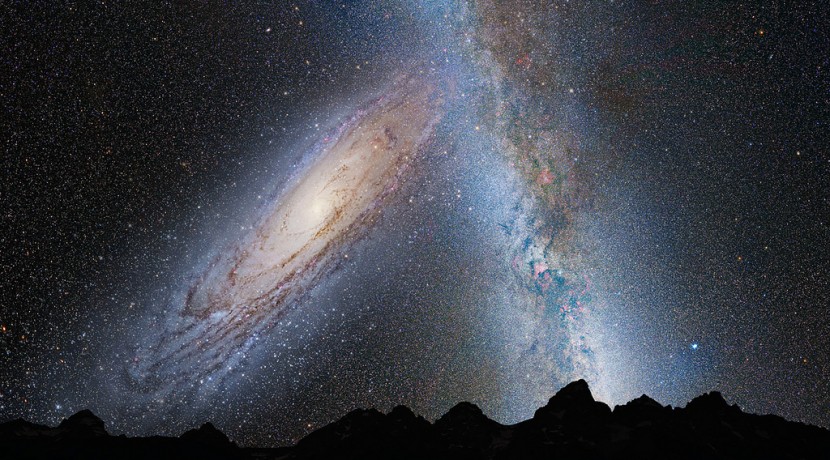I Was a Cosmos Virgin

This image represents Earth's night sky in 3.75 billion years, as Andromeda (left) fills the field of view and begins to distort the Milky Way with tidal pull.
Credit: NASA; ESA; Z. Levay and R. van der Marel, STScI; T. Hallas; and A. Mellinger
Confession: I never saw the original Cosmos series. I do remember my sister’s best friend in high school had a major crush on Carl Sagan, which we thought was hilarious, but it didn’t inspire this admittedly lackluster student to watch the show. (I’m proud to say my intellectual side ripened in college, but I still never caught Sagan’s Cosmos.)
After watching the first episode of the series reboot last night—brought to us in spectacular fashion by Fox, National Geographic, and an impressive production team that includes original Cosmos creators Ann Druyan and Steven Soter; Hollywood insider Seth McFarlane; and the wonderful astrophysicist Neil deGrasse Tyson as host—I’m glad to be onboard the “Ship of the Imagination” this time around.
The premiere episode opens with a bang—not the big one, but after President Obama gives his official imprimatur to the proceedings (nice touch), a gauntlet is thrown when Sagan’s voice intones, “The cosmos is all that is, or ever was, or ever will be.” Tyson takes over from there, promising viewers an adventure that will follow the evidence where it leads and will question everything. (Fasten your seatbelts, Young Earth creationists, it’s going to be a bumpy night!)
The Ship of the Imagination is a device borrowed from the original series that takes us into outer space, around our own planet, inside our bodies, and so on. This segment in the first episode was a little campy and a bit choppy but will certainly appeal to young viewers who love the Star Wars and Star Trek films. I must also note that for anyone who’s been lucky enough to see Neil deGrasse Tyson speak in person, or in other less scripted mediums, he seems almost restrained at times in his role as host. Even so, with his credentials, his sincerity, and dedication to exploring “the many ways of being alive,” I feel like we’re in very good hands.
Leading up to the series premiere, a great many writers who were kids or teenagers in 1980 recalled how bowled over they were by the original Cosmos (except for yours naïvely). It’s fair to say the revelations about space and time and human existence aren’t as mind-blowing to many today, and so as I watched the show with my nine- and six-year-old kids, I paid special attention to their reactions. Far and away the biggest impression on my six-year-old son was the story of Giordano Bruno, told in a dramatic animated sequence that’s the first of a recurring Cosmos segment called “Heroes of Knowledge.”
Bruno was the sixteenth-century Italian monk who, after secretly reading Lucretius, espoused the heretical view that as our planet circled the sun, so did many planets circle other stars he saw in the sky. Bruno was excommunicated for his views, and when he kept sharing them he was imprisoned and later burned at the stake.
It scared my son a little, and it captivated him. When the show as over, he kept asking, “Why? Why did they do that to him?” My husband and I explained that people who question authority and dare to dismantle a powerful structure (in this case the Church) by questioning the truth of its claims are often punished. We also stressed that when such outliers turn out to be right they’re seen as heroes by future generations. My son had a really hard time accepting that and it made me realize that watching a show like Cosmos is about reveling in the wonder of science and nature, but it’s also about enlightenment and facing some uncomfortable truths. It’s what makes the show profound, entertaining, and so very humanistic.
Perhaps the coolest moment of the episode comes when Tyson ventures into the theory of the multiverse (something not yet conceived of when the original aired). The special effects in the new Cosmos are top-notch (the rendering of the moon and the Earth’s formation, for example) and this is no exception, as our universe is depicted as one bubble among a swirl of bubbles moving ever-outward. No doubt, a collective “whoooaaa” went up in living rooms all over the world where the show was viewed.
The episode ended with the story of a teenage Tyson taking a bus to Cornell University where Sagan gave him a signed book, a campus tour, and even wrote down his home phone number in case Tyson had trouble getting back to the Bronx. While Tyson already knew he wanted to become a scientist, he says the experience showed him “the kind of person I wanted to become.” The story serves to humanize the idea of a scientist—that there’s a type of scientist to aspire to be and that not all scientists are good people (neither are all bus drivers or politicians or writers or—well, you get the idea). And so accusations of scientism are dealt with in a very subtle and artful way.
Having watched the first episode, I’ll continue to watch the series, and I definitely want to watch the original to compare styles and effects. Will Cosmos old and new become a cultural dichotomy, like Letterman or Leno? Admittedly they were rivals and so a better analogy might be who made a better Bond: Sean Connery or Roger Moore?
Truly, it’s beside the point. What matters is reaching a new audience (including yours truly and her kids) with the amazing story of the cosmos.Tags: Carl Sagan, COSMOS, neil degrasse tyson, TV
